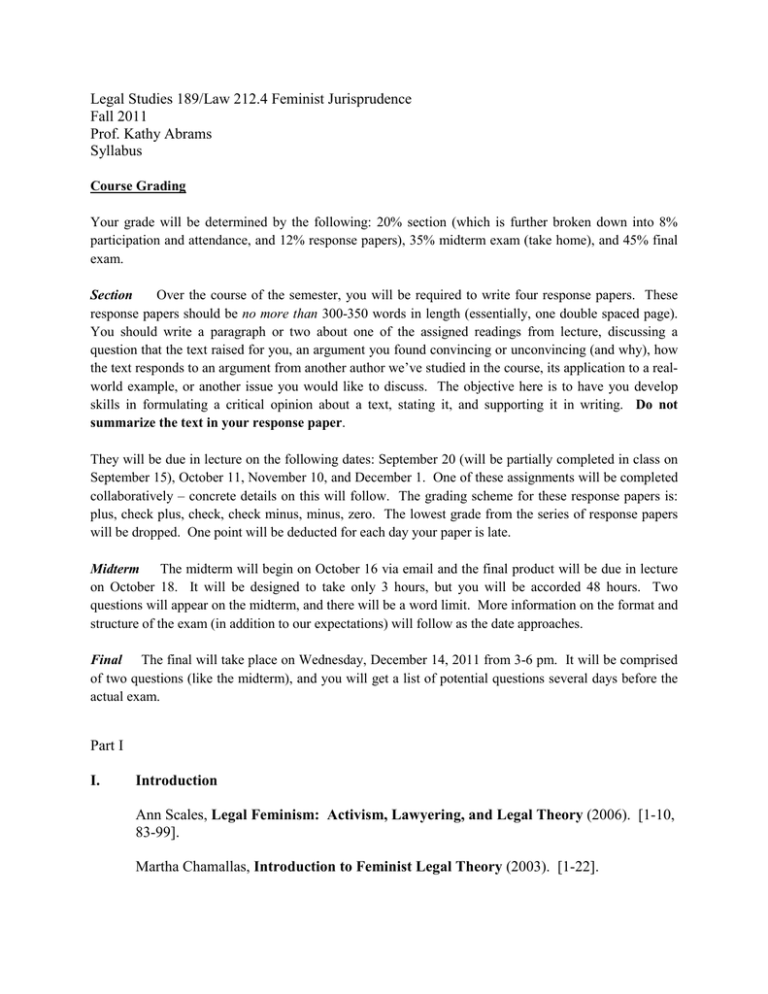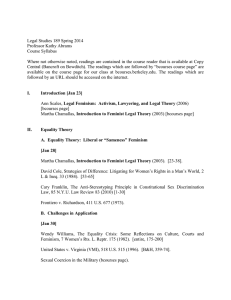
Legal Studies 189/Law 212.4 Feminist Jurisprudence
Fall 2011
Prof. Kathy Abrams
Syllabus
Course Grading
Your grade will be determined by the following: 20% section (which is further broken down into 8%
participation and attendance, and 12% response papers), 35% midterm exam (take home), and 45% final
exam.
Section
Over the course of the semester, you will be required to write four response papers. These
response papers should be no more than 300-350 words in length (essentially, one double spaced page).
You should write a paragraph or two about one of the assigned readings from lecture, discussing a
question that the text raised for you, an argument you found convincing or unconvincing (and why), how
the text responds to an argument from another author we’ve studied in the course, its application to a realworld example, or another issue you would like to discuss. The objective here is to have you develop
skills in formulating a critical opinion about a text, stating it, and supporting it in writing. Do not
summarize the text in your response paper.
They will be due in lecture on the following dates: September 20 (will be partially completed in class on
September 15), October 11, November 10, and December 1. One of these assignments will be completed
collaboratively – concrete details on this will follow. The grading scheme for these response papers is:
plus, check plus, check, check minus, minus, zero. The lowest grade from the series of response papers
will be dropped. One point will be deducted for each day your paper is late.
Midterm The midterm will begin on October 16 via email and the final product will be due in lecture
on October 18. It will be designed to take only 3 hours, but you will be accorded 48 hours. Two
questions will appear on the midterm, and there will be a word limit. More information on the format and
structure of the exam (in addition to our expectations) will follow as the date approaches.
Final The final will take place on Wednesday, December 14, 2011 from 3-6 pm. It will be comprised
of two questions (like the midterm), and you will get a list of potential questions several days before the
actual exam.
Part I
I.
Introduction
Ann Scales, Legal Feminism: Activism, Lawyering, and Legal Theory (2006). [1-10,
83-99].
Martha Chamallas, Introduction to Feminist Legal Theory (2003). [1-22].
II.
Equality Theory
A. Equality Theory: Liberal or “Sameness” Feminism
Martha Chamallas, Introduction to Feminist Legal Theory (2003). [23-38].
David Cole, Strategies of Difference: Litigating for Women’s Rights in a Man’s World, 2
L & Ineq. 33 (1984). [53-65]
Cary Franklin, The Anti-Stereotyping Principle in Constitutional Sex Discrimination
Law, 85 N.Y.U. Law Review 83 (2010) [1-30]
Frontiero v. Richardson, 411 U.S. 677 (1973).
B. Challenges in Application
Wendy Williams, The Equality Crisis: Some Reflections on Culture, Courts and
Feminism, 7 Women’s Rts. L. Reptr. 175 (1982). [entire, 175-200]
Michael M. v. Sonoma County Court, 450 U.S. 464 (1981). [B&H, 804-17]
United States v. Virginia (VMI), 518 U.S. 515 (1996). [B&H, 359-74].
Mari Matsuda, When the First Quail Calls: Multiple Consciousness as Jurisprudential
Method, 14 Women’s Rts. L. Rep. 297 (1992). [entire, 297-300]
Margaret Montoya, Mascaras, Trenzas, Y Grenas: Un/Masking the Self While
Un/Braiding Latina Stories and Legal Discourse, 17 Harv. Women’s L. J. 185 (1994).
[193-98, 201-09]
Christine Littleton, Equality and Feminist Legal Theory, 48 U. Pitt. L. Rev. 1043 (198687). [entire, 1043-59]
III.
Difference and Care
A. Difference Theory: The “Ethic of Care”
Martha Chamallas, Introduction to Feminist Legal Theory (2003). [39-44, 53-62].
Carol Gilligan, In a Different Voice (1980). [1-4, 24-65]
Carrie Menkel-Meadow, Portia in a Different Voice: Speculations on a Women’s
Lawyering Process, 1 Berkeley Women’s L. J. 39 (1985). [49-60]
Leslie Bender, From Gender Difference to Feminist Solidarity: Using Carol Gilligan and
an Ethic of Care in Law, 15 Vermont L. Rev. 1 (1990). [36-48]
B. Difference Theory: Care Work and Social Structures
Kathryn Abrams, The Second Coming of Care, 76 Chi-Kent L. Rev. 1605 (2001).
[entire, 1605-17]
Martha Fineman, The Neutered Mother, The Sexual Family and Other 20th Century
Tragedies (1995). [35-55]
Dorothy Roberts, Spiritual and Menial Housework, 9 Yale J. L. & Feminism 51 (1997).
[51-70]
California Federated Savings & Loan Association v. Guerra, 479 U.S. 272 (1987).
[B&H, 311-16]
Michael Fischl, A Woman’s World: What if Care Work Were Socialized and Police and
Fire Protection Left to Individual Families, 52 Buff. L. Rev. 659 (2004) [666-77].
IV.
Dominance Feminism
A. Dominance Theory
Catharine MacKinnon, Difference and Dominance: On Sex Discrimination, and
Afterword in Feminism Unmodified (1987). [32-45, 215-28]
Catharine MacKinnon, Feminism, Marxism
Jurisprudence, 8 Signs 635 (1983). [646-58]
and
Method:
Toward
Feminist
Catharine MacKinnon, Reflections on Sex Equality Under Law, in Women’s Lives,
Men’s Laws (2005) [127-46].
B. Theory in Action: Sexual Harassment
Catharine MacKinnon, The Sexual Harassment of Working Women (1979). [1-23].
Tanya Kateri Hernandez, The Racism of Sexual Harassment, in Catherine MacKinnon &
Reva Siegel, Directions in Sexual Harassment Law (2004). [479-95]
Adrienne Davis, Slavery and the Roots of Sexual Harassment, in Catherine MacKinnon
& Reva Siegel, Directions in Sexual Harassment Law (2004) [457-72]
Sumi Cho, Converging Stereotypes in Racialized Harassment: Where the Model
Minority Meets Suzie Wong, 1 J. of Gender, Race, & Justice 177 (1997). [182-99]
Meritor Savings Bank v. Vinson, 477 U.S. 57 (1986).
Rabidue v. Osceola Refining Co., 805 F.2d 611 (6th Cir. 1986).
Harris v. Forklift Systems, Inc., 510 U.S. 17 (1993).
Vicki Schultz, The Sanitized Workplace Revisited, in Martha Fineman, Jack Jackson, &
Adam Romero, eds., Feminism and Queer Theory: Intimate Encounters,
Uncomfortable Conversations (2009) [65-90]








